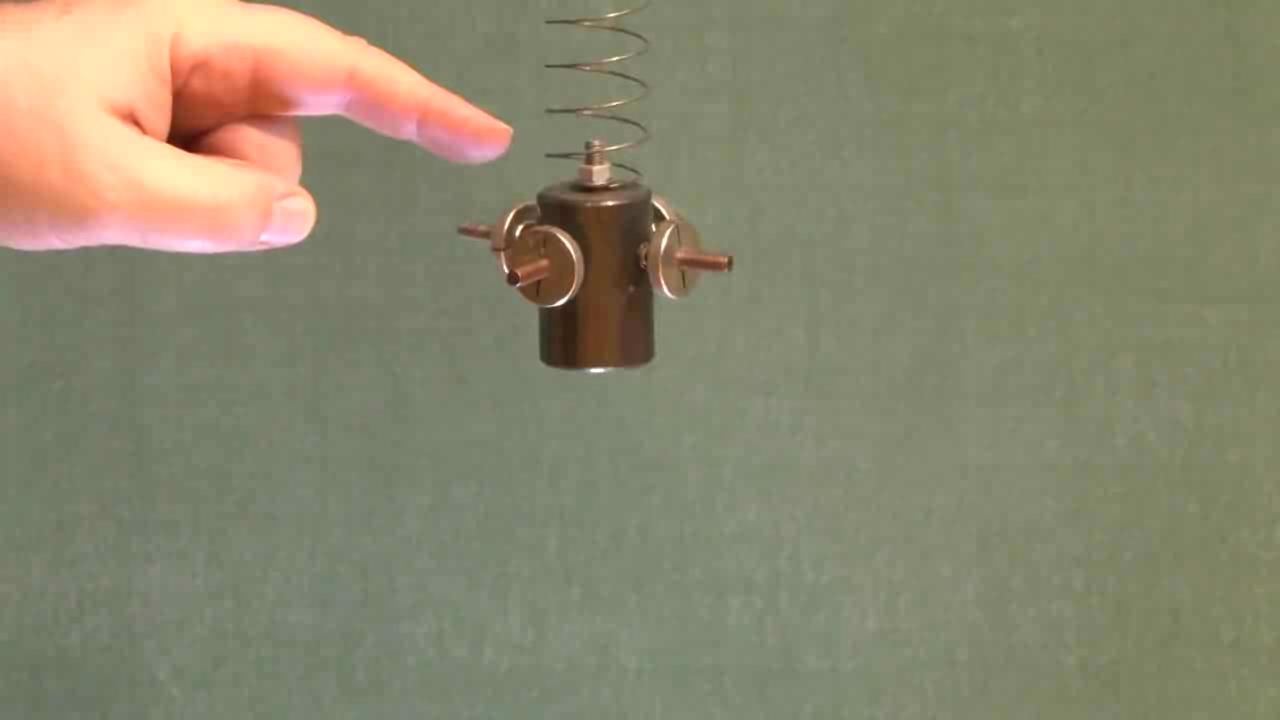„Wilberforce inga” változatai közötti eltérés
(Új oldal, tartalma: „Kategória:Szerkesztő:Hartlein <wikitex> thumbtime=0:30 == Az elhangzó szöveg == szöveg == angol név == angol szöveg <…”) |
|||
| (egy szerkesztő 9 közbeeső változata nincs mutatva) | |||
| 1. sor: | 1. sor: | ||
[[Kategória:Szerkesztő:Hartlein]] | [[Kategória:Szerkesztő:Hartlein]] | ||
<wikitex> | <wikitex> | ||
| − | [[ | + | [[Fájl:wilberforce_inga.ogv|thumbtime=0:16|bélyegkép|720px|[[Wilberforce inga]]]] |
== Az elhangzó szöveg == | == Az elhangzó szöveg == | ||
| − | + | Wilberforce inga | |
| − | + | 1895-ben [http://en.wikipedia.org/wiki/Lionel_Robert_Wilberforce Lionel Wilberforce] a Cavendish laboratórium munkatársa egy érdekes fizikai demonstrációt mutatott be. A kísérletben szereplő eszköz azóta viseli a nevét, ez a Wilberforce inga. Az inga egy csavarrugóból, amely felső vége mereven rögzített és a másik végére mereven rögzített súlyból áll. Kétféle módon indíthatjuk el, hozhatjuk mozgásba az ingát. Megemeljük a súlyt és magára hagyjuk, ekkor kezdetben transzlációs rezgést fog végezni. Vagy forgatással is elindíthatjuk, ekkor torziós lengéseket fog végezni. | |
| − | + | Ha a kétféle rezgés rezgésszáma megegyezik, vagy csak kicsit különbözik, akkor csatolt rezgés jön létre a kétféle módus között. Ezen az ingán egyszerre kétféle rezgés is létrejön, a súly függőleges, transzlációs mozgása és a rúgó tengely körüli forgó, rotációs mozgása. A két mozgás frekvenciáját a súlyra szerelt állítócsavarokkal lehet összehangolni, a tehetetlenségi nyomaték változtatásával. | |
| + | |||
| + | Belátható, hogy a tömeg állandósága miatt a frekvenciák összehangolása csak a tehetetlenségi nyomaték megváltoztatásával lehetséges, ami az állítócsavarok segítségével történik. Az így beállított ingán létrejön a csatolás a transzlációs és a rotációs rezgések között. | ||
| + | |||
| + | |||
| + | == Wilberforce Pendulum == | ||
| + | |||
| + | In 1895, Lionel Wilberforce, a member of the Cavendish laboratory, demonstrated an interesting physics experiment. Since then the equipment used in the experiment was known as the Wilberforce pendulum. The pendulum is composed of a coil spring, one end of which is fixed, the other attached to a mass. We can start it in two ways. We can lift the mass and leave it to start itself, in which case we will observe translational oscillations. We can also start it by twisting it, in which case the result will be a torsional oscillations. | ||
| + | |||
| + | If the rev of both motions is the same or nearly the same, then we will see a coupled oscillation between the two modes. Two different kinds of oscillation occur at once, the perpendicular, translational motion of the mass and the rotational motion around the axis of the spring. The frequency of both motions can be adjusted to each other with the adjustable screws on the mass, which allow us to change the moment of inertia. | ||
| + | |||
| + | We can see that because of the conservation of mass, the phasing of the frequencies can only be acheived by changing the moment of inertia, which can be acheived by adjusting the screws. A pendulum adjusted in this way will allow coupling between the translational and rotational oscillations. | ||
</wikitex> | </wikitex> | ||
A lap jelenlegi, 2014. március 9., 13:33-kori változata
Az elhangzó szöveg
Wilberforce inga
1895-ben Lionel Wilberforce a Cavendish laboratórium munkatársa egy érdekes fizikai demonstrációt mutatott be. A kísérletben szereplő eszköz azóta viseli a nevét, ez a Wilberforce inga. Az inga egy csavarrugóból, amely felső vége mereven rögzített és a másik végére mereven rögzített súlyból áll. Kétféle módon indíthatjuk el, hozhatjuk mozgásba az ingát. Megemeljük a súlyt és magára hagyjuk, ekkor kezdetben transzlációs rezgést fog végezni. Vagy forgatással is elindíthatjuk, ekkor torziós lengéseket fog végezni.
Ha a kétféle rezgés rezgésszáma megegyezik, vagy csak kicsit különbözik, akkor csatolt rezgés jön létre a kétféle módus között. Ezen az ingán egyszerre kétféle rezgés is létrejön, a súly függőleges, transzlációs mozgása és a rúgó tengely körüli forgó, rotációs mozgása. A két mozgás frekvenciáját a súlyra szerelt állítócsavarokkal lehet összehangolni, a tehetetlenségi nyomaték változtatásával.
Belátható, hogy a tömeg állandósága miatt a frekvenciák összehangolása csak a tehetetlenségi nyomaték megváltoztatásával lehetséges, ami az állítócsavarok segítségével történik. Az így beállított ingán létrejön a csatolás a transzlációs és a rotációs rezgések között.
Wilberforce Pendulum
In 1895, Lionel Wilberforce, a member of the Cavendish laboratory, demonstrated an interesting physics experiment. Since then the equipment used in the experiment was known as the Wilberforce pendulum. The pendulum is composed of a coil spring, one end of which is fixed, the other attached to a mass. We can start it in two ways. We can lift the mass and leave it to start itself, in which case we will observe translational oscillations. We can also start it by twisting it, in which case the result will be a torsional oscillations.
If the rev of both motions is the same or nearly the same, then we will see a coupled oscillation between the two modes. Two different kinds of oscillation occur at once, the perpendicular, translational motion of the mass and the rotational motion around the axis of the spring. The frequency of both motions can be adjusted to each other with the adjustable screws on the mass, which allow us to change the moment of inertia.
We can see that because of the conservation of mass, the phasing of the frequencies can only be acheived by changing the moment of inertia, which can be acheived by adjusting the screws. A pendulum adjusted in this way will allow coupling between the translational and rotational oscillations.
